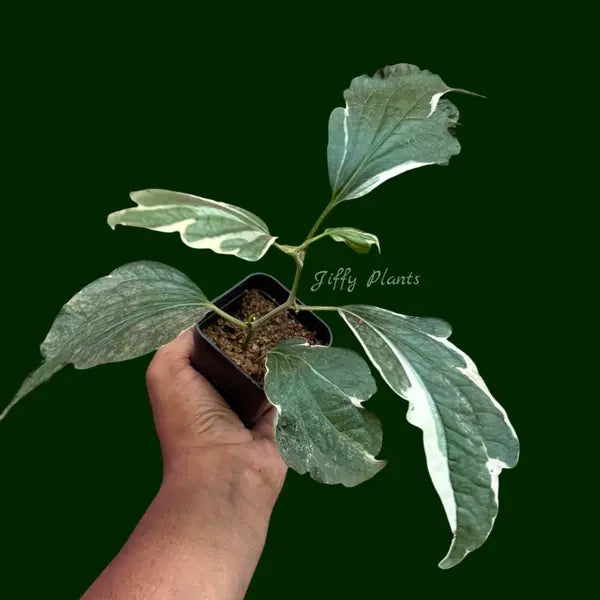
Piper Sarmentosum Variegated
Size: Single Plant | 2.5" Pot Included
The Piper Sarmentosum Variegated is a beautiful and somewhat rare plant known for its striking variegated leaves. While the general care for Piper Sarmentosum Variegated applies, the variegated variety often requires slightly brighter light to maintain its vibrant patterns.
Here's a detailed guide to Piper Sarmentosum Variegated's care:
1. Light:
Bright, indirect light is ideal. This plant thrives in a spot where it receives plenty of natural light but is shielded from direct, harsh sun, which can scorch its delicate leaves and fade the variegation.
It can tolerate partial shade, but variegated varieties need more light to keep their unique color patterns.
If the plant becomes leggy or the variegation starts to fade, it might need more light.
Rotate your plant occasionally to ensure even growth.
2. Watering:
Keep the soil consistently moist but not waterlogged. Piper sarmentosum does not tolerate drought well, so regular watering is important, especially during warmer months.
Water when the top few centimeters (about an inch) of soil feel dry to the touch.
Ensure good drainage to prevent root rot. Overwatering can lead to yellowing and wilting leaves or a noticeable rotten odor.
3. Humidity:
Being a tropical plant, Piper Sarmentosum Variegated loves high humidity (70-90% is ideal).
If your indoor air is dry, especially during winter, consider using a humidifier or placing the pot on a tray filled with pebbles and water (make sure the pot isn't sitting directly in the water).
Regular misting can also help increase humidity.
4. Temperature:
It thrives in warm conditions, ideally between 18∘C to 29∘C (65∘F to 85∘F).
Protect it from cold drafts and sudden temperature changes, which can stress the plant and cause leaf drop. Avoid placing it near air conditioners or heating vents.
5. Soil:
A well-draining, fertile potting mix is crucial.
A mix containing peat, perlite, and organic matter works well. The soil should retain moisture without becoming soggy.
A blend of garden soil with organic compost is also effective.
6. Fertilization:
Feed every 4-6 weeks during the growing season (spring and summer) with a balanced, water-soluble fertilizer.
Reduce or stop feeding in autumn and winter when the plant's growth slows down. Piper plants are not heavy feeders, so "less is more" when it comes to fertilizer.
7. Pruning:
Pruning can help maintain the desired shape and size and encourage bushier growth.
Use clean, sharp shears to cut just above a leaf node.
Remove any yellow or damaged leaves to keep the plant healthy.
8. Repotting:
Repot in the spring every 1-2 years or when the plant becomes root-bound.
Choose a pot that is only one size larger than the current one and has good drainage holes.
9. Propagation:
Piper sarmentosum Variegated can be propagated through stem cuttings.
Take a healthy cutting with at least two nodes (for optimal rooting success, especially with 2-node cuttings).
Remove the lower leaves and place the cutting in water or moist soil.
Keep the cutting in a warm, humid environment until roots develop. Using rooting hormone (like IBA at 1,000 mg/L) can improve sprouting and growth.
10. Common Problems:
Fading Variegation: Insufficient light can cause the variegation to fade. Provide brighter, indirect light.
Yellowing Leaves: Can be a sign of overwatering (soggy soil and root rot) or insufficient light. Check soil moisture and light conditions.
Leaf Drop: Often caused by too low light, cold drafts, or low humidity.
Pests: Susceptible to common houseplant pests like aphids, spider mites, and mealybugs. Inspect your plant regularly and treat promptly with insecticidal soap or neem oil if you spot any.
Clear, white, or black dots on undersides of leaves: These are often natural exudates (sugar secretions) or cystoliths (mineral deposits), not necessarily a sign of pests. Exudates are part of the plant's natural defense mechanism and can attract beneficial insects like ants. Abundant exudate might indicate too much light.
By providing these optimal conditions, your Piper sarmentosum Variegated should thrive and display its beautiful foliage!

